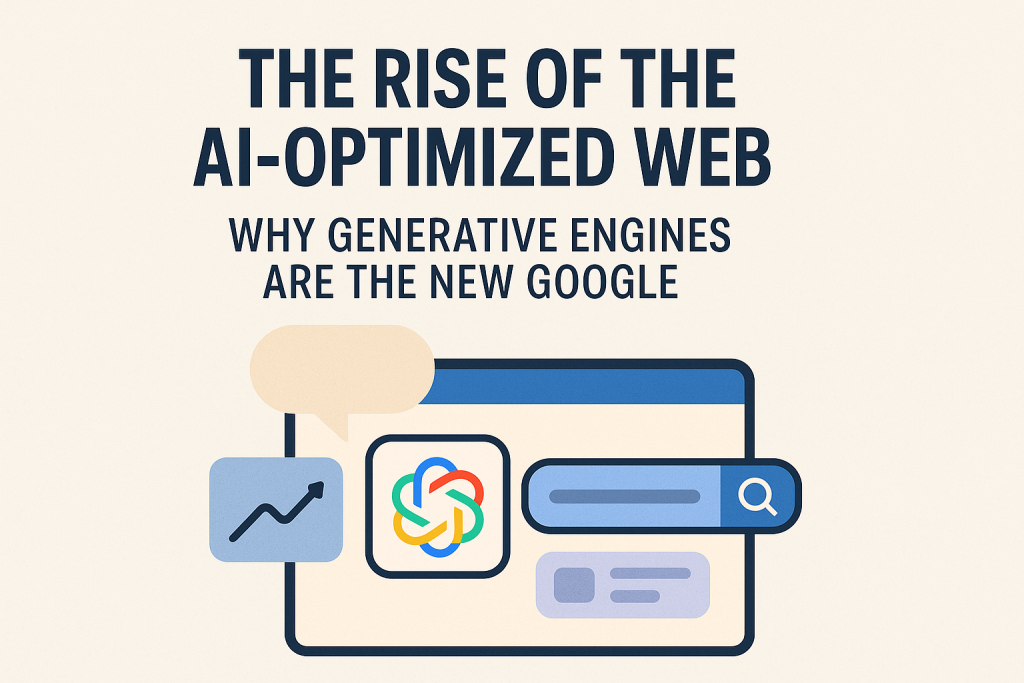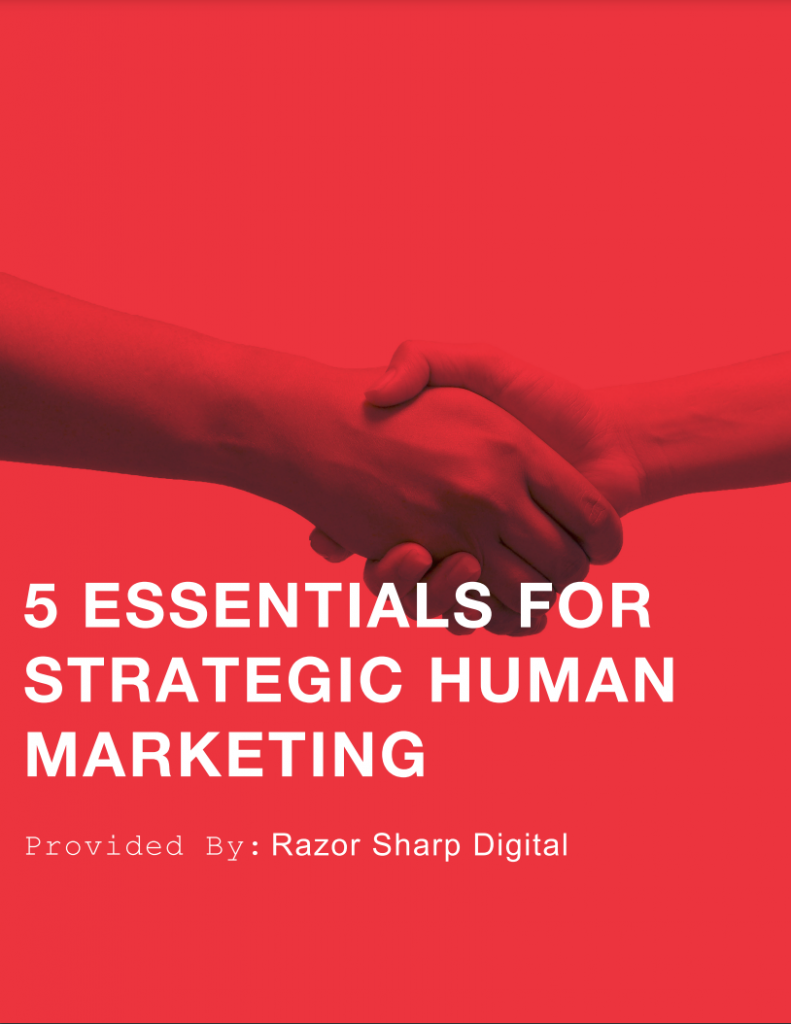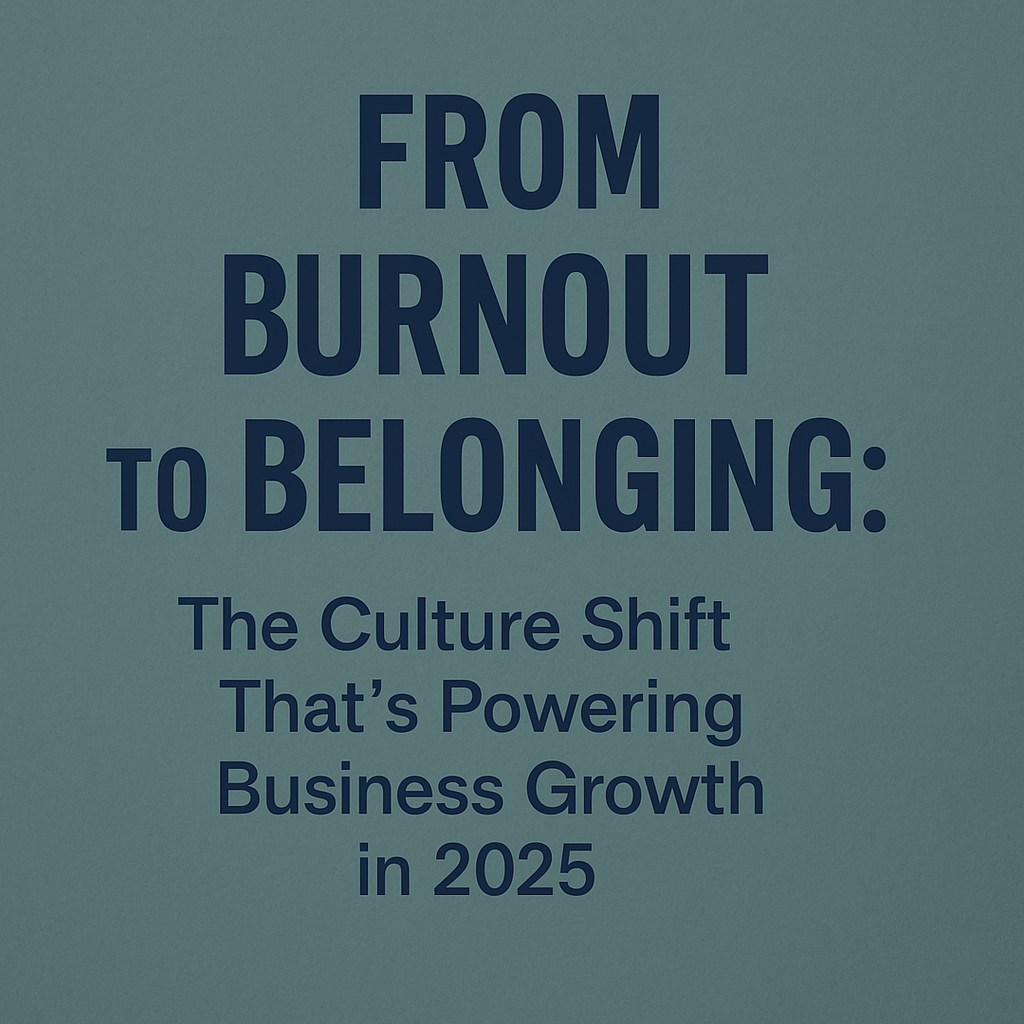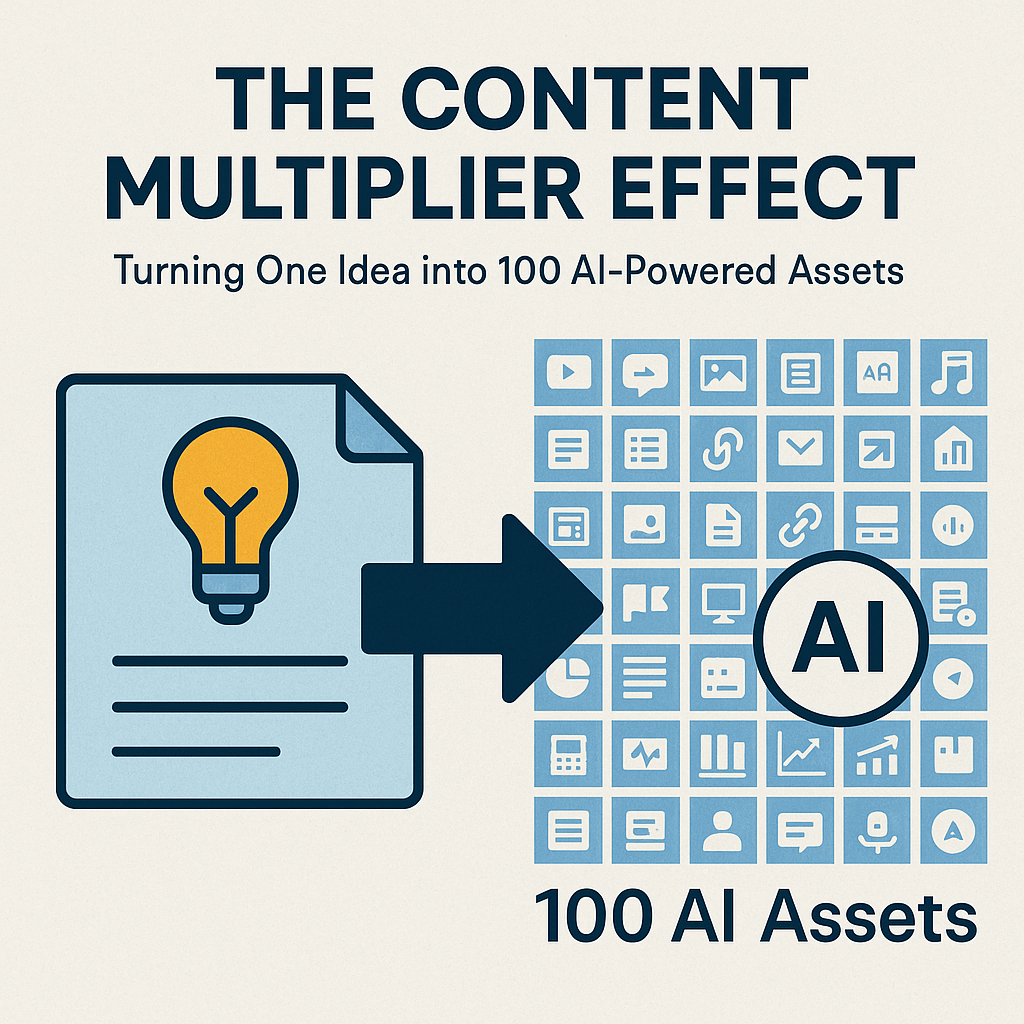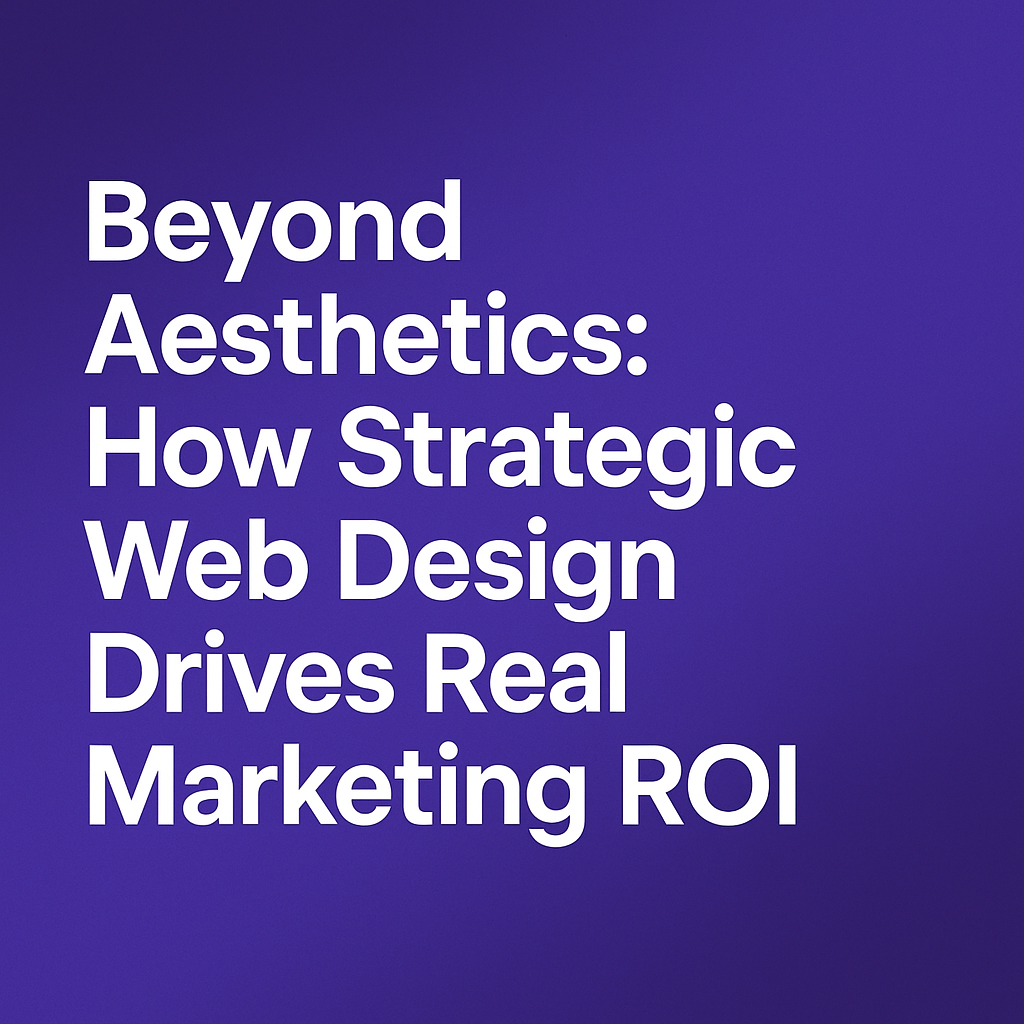But today, a tectonic shift is underway. Generative AI engines—conversational systems powered by large language models (LLMs) and retrieval-augmented generation (RAG)—are reimagining how users interact with information. Rather than navigating a list of links, users increasingly expect a single, coherent, synthesized answer, backed by citations or source references. As this shift accelerates, generative engines are emerging not merely as supplements to search engines, but as the new frontier of discovery.
In this article, we’ll walk through:
-
What generative engines are and how they differ from traditional search
-
Why the AI-optimized web is rising in influence
-
The challenges and stakes for publishers and brands
-
How to optimize for this new paradigm via GEO (Generative Engine Optimization)
-
What the future of discovery may look like
Let’s begin by defining our terms.
What Are Generative Engines vs. Search Engines?
Traditional Search Engines: Index + Rank + Present Links
Search engines like Google, Bing, or DuckDuckGo operate through a pipeline of:
-
Crawling — bots traverse the web to find pages
-
Parsing & Indexing — pages are analyzed, stored, structured
-
Ranking & Retrieval — for a user’s query, relevant indexed pages are ranked by signals (keywords, backlinks, authority, freshness, etc.)
-
Presentation — a Search Engine Results Page (SERP) shows links, snippets, sometimes featured snippets or knowledge panels
If users find what they want, they click through to content. This paradigm has been the foundation for SEO for years.
Generative Engines: Synthesize, Summarize, Serve
Generative engines like ChatGPT (with web-access or browsing plugins), Google’s Search Generative Experience (SGE) or AI Overviews, Perplexity, Claude, and others work differently. They:
-
Retrieve relevant sources (web, knowledge bases, APIs)
-
Extract and synthesize key information
-
Generate a coherent, conversational answer (not a list of links)
-
Cite sources or at least provide attribution to driving content
In effect, generative engines aim to reduce friction: users can get answers (and often “action steps”) without clicking through multiple pages, especially for simple or fact-based queries. TechTarget+2upGrowth+2
Some key differences:
-
Conversational context: They remember context across follow-up queries
-
Semantic understanding: They interpret nuance and intent, not just keywords
-
Answer synthesis: They combine multiple sources into a unified summary
-
Zero-click delivery: Many queries may not lead to a click at all
As a result, some traditional parts of SEO (like aiming for “position 1” on a SERP) may no longer guarantee visibility in this AI-driven ecosystem.
Why the AI-Optimized Web Is Gaining Momentum
Explosion in Generative Traffic Growth
One stark data point: generative AI–driven traffic is growing 165× faster than organic search across multiple verticals. WebFX While traditional channels (paid, direct, referral, organic) still dominate absolute volume, the growth trajectory suggests generative engines are rapidly catching up.
Users Prefer Faster, Conversational Answers
Modern users increasingly want direct, to-the-point answers rather than browsing a dozen links. With mobile, voice assistants, and multitasking users, the convenience of an AI that just gives the answer is compelling. lizard.global+1
The Zero-Click Problem and Traffic Erosion
Because generative engines deliver answers right in the interface (sometimes above or in lieu of links), content creators risk losing clicks. This is already evident: Google’s AI Overviews have contributed to a rising share of “zero-click” searches—search queries where users don’t click through to any result. Wikipedia+2New York Post+2 Content publishers and news sites have seen traffic declines in cases where AI summaries preempt clicks. New York Post+2AP News+2
The Shift in Incentive: From Ranking to Citation
In this new paradigm, it’s not enough just to show up on page one—you want to be cited in the AI-generated summary. Generative engines prioritize information gain, context depth, and credibility when choosing which sources to cite. upGrowth+2arXiv+2 In practical terms, that means demonstrating expertise, providing rich context, and being easily machine-scannable.
Academic Validation: GEO as a New Discipline
Recent academic research frames this shift explicitly. The paper “GEO: Generative Engine Optimization” introduces the concept of optimizing content to maximize the chance of being picked, cited, or synthesized by generative systems. arXiv Another recent study, “Characterizing Web Search in The Age of Generative AI,” compared traditional search vs generative output across domains, highlighting key structural differences in discovery. arXiv
The rise of GEO signals that this is no passing trend—it’s a structural evolution of how discovery works.
The Stakes: Challenges & Risks for Publishers and Brands
Visibility Doesn’t Always Translate to Clicks
Being cited in an AI-generated answer may show your content, but it doesn’t always drive traffic. Many users are satisfied with the summary itself. That means attribution matters more than ever (e.g. the text “according to X source”).
Opacity and Unpredictability
Generative engines are often black boxes. You don’t always know why a given source was selected or how much weight different signals carry. That uncertainty complicates strategy. arXiv+1
Big Brand Bias & Authority Gatekeeping
Large, established brands or high-authority domains may have inherent advantages in being selected or trusted by AI systems. Smaller players may struggle to break in. Wikipedia+3arXiv+3arXiv+3
Content Quality & Misinformation Risks
Generative AI can hallucinate or present information confidently but incorrectly. If a cited source is misunderstood or misused, it can propagate error. Publishers must carefully ensure clarity, factual grounding, and rigorous sourcing.
Monetization & Attribution Models
If fewer users click through to a site, traditional ad models suffer. The web economy may need new paradigms—e.g. licensing, content partnerships, API-based attribution, or micropayments for citations.
Algorithmic Disintermediation
In some cases, generative engines may entirely bypass traditional content distribution channels, aggregating and summarizing knowledge from multiple sources into a new “AI-native” layer—essentially creating a web whose interface is built for AI first, humans second. Le Monde.fr+2upGrowth+2
How to Adapt: Generative Engine Optimization (GEO) Strategies
Given the shift in mechanics, brands and creators must evolve from SEO-first thinking into GEO-aware tactics. Below is a toolkit to adapt.
1. Embrace Authoritativeness, Expertise & Trust (E-E-A-T+G)
Just as traditional SEO emphasizes E-A-T (Expertise, Authority, Trust), GEO demands demonstrating deep expertise and trust signals in a way that AI systems will favor:
-
Cite reputable sources, data, studies, citations
-
Use named authors and bio context where possible
-
Present original insights or unique data, not just rehashed aggregates
-
Keep content fresh and regularly updated
2. Structure with Clarity for Machine Parsers
Generative systems often parse content quickly, so structure matters:
-
Use clear headings, subheadings, and hierarchy
-
Use FAQ sections or direct Q&A blocks
-
Employ schema markup / structured data (e.g. ArticleSchema, FAQ schema)
-
Use bullet lists, tables, and easily parsable formats
-
Maintain clean HTML (avoid excessive noise or random scripts)
3. Optimize for Information Gain Rather Than Repetition
Generative engines prefer content that adds value rather than repeats basics. Avoid overly shallow definitions. Instead:
-
Offer deeper context, case studies, examples
-
Use comparisons, trade-offs, visuals, data layers
-
Anticipate follow-up questions and branch out
-
Explore edge cases, advanced angles, emerging issues
4. Align with Query Intent & Conversational Tone
Because generative systems interpret intent semantically:
-
Write conversationally, anticipating how users ask questions
-
Use question-based headings (e.g. “Why does X matter?” “How to do Y step-by-step?”)
-
Use natural language and synonyms, not forced keyword insertion
-
Address both short (broad) and long-tail (specific) queries
5. Cite, Reference, Attribute
If your content can be a citation, it is more likely to get selected:
-
Include references and sources inline, especially for claims
-
Use consistent, standard citation structure
-
Link to original research or data when applicable
-
Avoid ambiguous or anonymous statements
6. Monitor & Measure AI Visibility
Keep track not just of rankings, but of how often your content is mentioned or cited by AI systems:
-
Use tools or platforms that monitor AI Overviews, ChatGPT answers, Perplexity citations
-
Track mentions (brand, URL) in AI-generated outputs
-
Test different phrasings of your content and see how AI responds
-
A/B variations to see which version is more likely to be selected
7. Combine GEO with Traditional SEO (Don’t Abandon SEO)
GEO doesn’t replace SEO—it complements it. You still want your content discoverable in SERPs, indexable, fast, mobile-friendly, and linked. Think of GEO as an extra layer rather than a replacement. Wikipedia+3TechTarget+3upGrowth+3
8. Domain Diversity & Cross-Linking
Because generative engines sometimes sample across domains:
-
Build content across related domains or subdomains (if feasible)
-
Cross-link high-authority pages in relevant contexts
-
Create topic clusters so AI can “see” breadth and depth
9. Be Strategic About Formats
Some content types are more AI-friendly:
-
Guides / Pillars that cover broad topics
-
How-to / step-by-step tutorials
-
FAQ / Q&A pages
-
Data-driven reports / case studies / research
-
Summaries & differentiators (e.g. “pros/cons,” “vs.”)
10. Consider AI-only or API-first Versions
Some forward-thinking brands are maintaining AI-optimized versions of content, or API endpoints (or “llms.txt” files) that directly feed generative agents. These might live alongside user-facing pages, specifically tuned for machines. Wikipedia+1
Example: How a Topic Might Shift in Practice
Let’s say your company writes a guide on “How to Choose a Project Management Tool.”
-
Under SEO, your goal might be to rank for “project management tool comparison” + backlinks + meta optimization.
-
Under GEO, you’d also ensure your content is deeply structured, includes data, edge cases (for specific industries), common follow-up questions (“What about integration with Slack?”), and is well cited.
-
You might include a “Q&A” at the bottom (“Is PM tool needed for small teams?” “How to migrate?”).
-
Your content could be rewritten in multiple micro-variations to match different phrasings AI might query.
-
You might build a slim “AI-optimized summary” version with just the core facts, for the generative engine to pull.
If you succeed, generative engines might cite your guide directly when users ask, “Which project management tool should I choose?” instead of merely returning a SERP link.
What the Future Could Look Like
Discovery as Conversation
Instead of search → click → read, the future may be more like:
User: “What’s the best CRM for small nonprofits?”
AI Engine: (gives a 2–3 paragraph summary) “Based on feature sets, cost, and integrations, NonprofitCRM X tends to outperform for small orgs. Source: NonprofitTechBlog, 2025, CRMUserDataReport. Want to see alternatives or pricing?”
User: “Show me the top 3 with lowest monthly cost.”
AI Engine: (narrowed answer with quick side-by-side)
User: “Give me links to reviews and comparisons.”
AI Engine: (then provides clickable sources)
This interaction style shifts the user experience from “browse results” to “refine a conversation.”
Multi-Modal, Agentic Interfaces
Expect more voice, visual, and multi-modal search integrated with generative AI. You might upload a photo, ask “What’s wrong with this device?” and get a step-by-step fix. Or ask an AI agent to book a flight for you, with the AI autonomously querying multiple sources and executing tasks. lizard.global+2TechTarget+2
Growth of AI-First Content & AI Partnerships
Some publishers may create AI-native content—written expressly for machine consumption, e.g. modular, citation-ready micro-segments. Also, we might see rising publisher / AI partnerships (licensing content directly) rather than relying solely on organic inclusion. Indeed, some content companies already negotiate with AI platforms to have their content surfaced. Le Monde.fr+2upGrowth+2
New Metrics & Business Models
Clicks, sessions, bounce rate—these may lose relevance in a world of zero-click delivery. Instead, we may see metrics like:
-
Citation share (how often your content is cited)
-
Attributed value per citation
-
AI-driven conversions / engagements
-
Licensing / API revenue
Publishers may move toward subscription or data-licensing models tailored to AI engines.
Reinvention of SEO + GEO
SEO and GEO will increasingly merge. You’ll see hybrid metrics: content designed to satisfy AI systems and humans, with tooling that tests how your content fares in SERPs and in generative engines. Advances like Role-Augmented Intent-Driven G-SEO (a recent study) propose ways to steer content optimization for generative systems by modeling conversational roles and intent. arXiv
A Checklist: Getting Started Toward AI-Optimized Web Presence
| Task |
Purpose |
Example Action |
| Audit top content |
See which pages have traction or citation potential |
Use AI-mention monitoring tools, check whether pages appear in AI Overviews |
| Reformat high-potential pages |
Make them machine-friendly |
Add Q&A blocks, FAQ schema, better headings |
| Update with deeper content |
Raise information depth above the baseline |
Add research, side cases, comparative tables |
| Add inline citations |
Improve cred and pickability |
“According to [Study Name, 2024]” with link |
| Create AI-signal content versions |
Serve generative engines more directly |
A “short summary” version for AI agents |
| Monitor and iterate |
Track what gets cited, adjust phrasing or format |
Test alternate headings, query rewrites |
| Build internal link / cluster depth |
Show breadth & depth to AI agents |
Topic clusters, pillar pages, cross-domain |
| Partner or license content |
Explore new revenue paths |
Negotiate with AI platforms to surface your content |
The rise of the AI-optimized web is not a marginal shift—it’s a foundational transformation in how information is discovered, delivered, and consumed. Generative engines are not just an experiment or overlay: they are steadily becoming the new Google—the interface between users and knowledge.
For content creators, marketers, and publishers, the stakes are high. The old playbook of SEO alone is no longer enough. To remain visible, relevant, and viable, brands must adopt Generative Engine Optimization (GEO) strategies: structure content for machines, emphasize information gain, optimize for citation, and monitor AI visibility.
The good news is this new frontier rewards authenticity, clarity, and depth. Those who adapt early—who become trusted, machine-readable sources—stand to thrive in a world where generative AI is the first stop for human inquiry.



